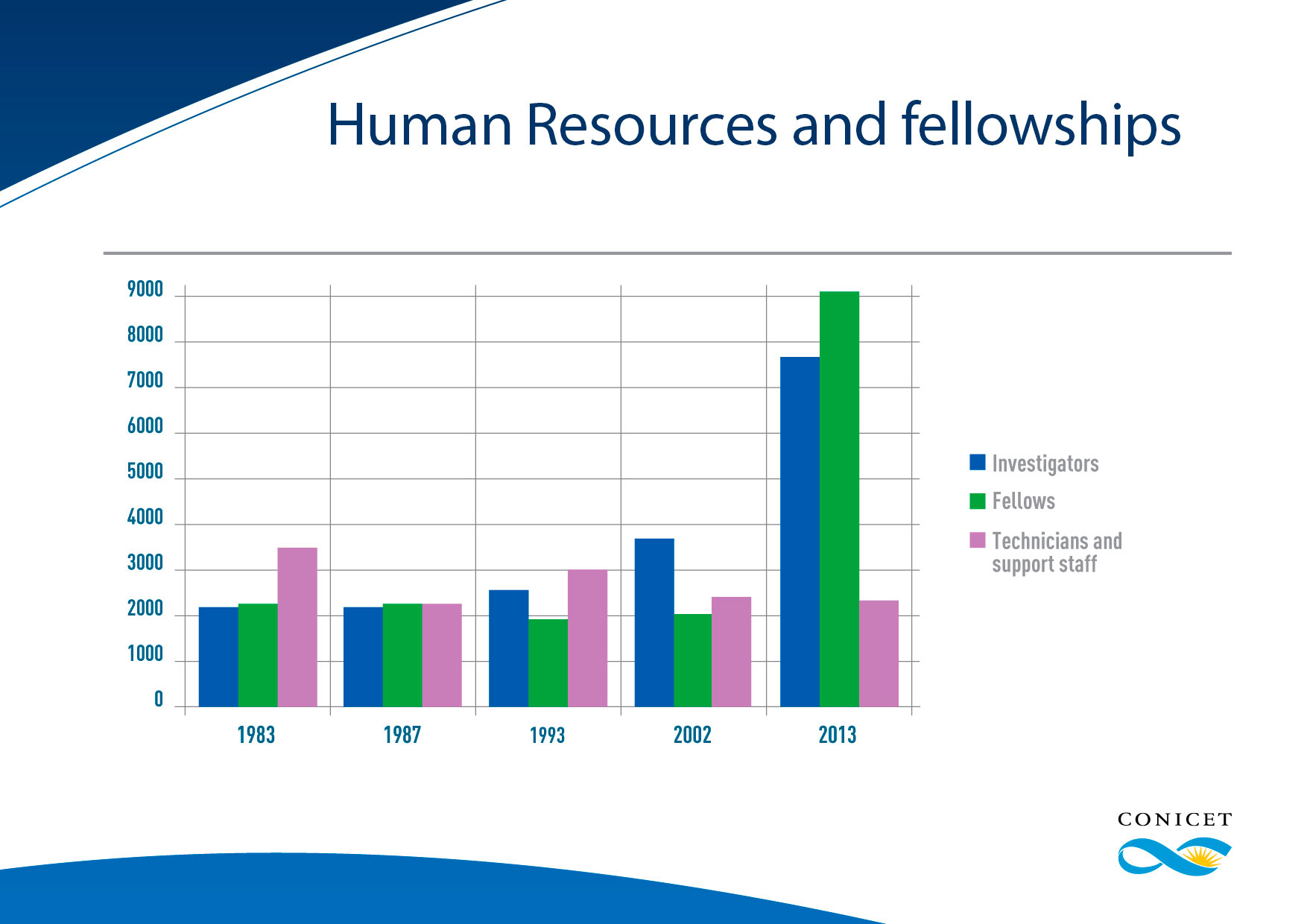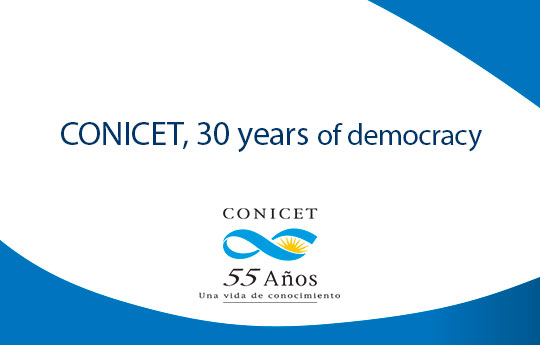CONICET, 30 years of democracy
This material pretends to be a starting point for a debate based on concrete data about the past and the current reality of the National Scientific and Technical Research Council (CONICET).
This material pretends to be a starting point for a debate based on concrete data about the past and the current reality of the National Scientific and Technical Research Council (CONICET). The numbers presented show the result of public policies implemented by different governments over the last 30 years.
This information illustrates the evolution of human resources, infrastructure, as well as centres and institutes of the Council, as a result of policies of Science and Technology. The data clearly reflects the most important crisis of the CONICET, at the end of the nineties, and its following recovery from 2003.
In order to understand the context of these years and its magnitude, it is important to remember the article published in the newspaper “La Nación”, on November 7, 1999, entitled: The future of the CONICET, “Under guarded prognosis”. The following year, on August 6, 2000, the same newspaper entitled “The second death of Houssay”, referring to the attempt to eliminate the career of Scientific and Technologic Investigator. This serious situation shows the remarkable recovery of CONICET from the year 2003 thanks to the policy of Science and Technology implemented by the new government.
The numbers hereby presented demonstrate the unprecedented effort in the training of human resources and infrastructure allocated to research and technological development of the country. Considering historical context, what has been achieved from 2003 could be considered a refounding of the CONICET.
The numbers of the CONICET
Within the framework of the history of the Argentine scientific system, the CONICET presents statistics from the return of democracy to the present. They pretend to be an instrument to debate with scientific accuracy what happened to the institution. The growth experienced during the last decade is the result of different policies of Science and Technology carried out in the country.
Human Resoruces
The evolution of the number of investigators, Technicians and support staff and fellowship programmes (PhDs and Postdoctorates) is the most important parameter to observe the effect of the different policies developed in the last 30 years taking, into account that human resources represent the most valuable asset of the CONICET and of any other scientific and technical institution in the world.
The values from the graph reveal the stagnation of the CONICET in the number of investigators and fellows (PhDs and Postdoctoral) in the period 1983-2002. The numbers of these 20 years show that there was no significant variation regarding the initial situation of the Council at the beginning of democracy (1983). Nevertheless, during the period 2003-2013 there is a clear strengthening of the CONICET with a remarkable increase in the number of investigators and fellows.

As regards the Career of Scientific Investigators and annual fellowships, in 1997, 125 investigators joined the Council and 300 fellowships were granted. In the 2001, 160 scientific investigator’s positions (1999 contest) and 30 fellows were incorporated. There is a substantial change in 2004: 400 investigators were admitted and 1300 fellowships were granted. Finally, in 2012, the CONICET incorporated 606 investigators and granted 3900 PhDs and Postdoctal fellowships.
The evolution of the number of technicians deserves another chapter, because it remains without variations after a relevant decline during the eighties. This sector, so important for the CONICET, demands an active policy of strengthening that accompanies the growth in the number of researchers and the acquisition of new equipment that occurred in the last ten years.
Part of the stagnation of the sector of technicians and support staff lies in the prioritization of the incorporation of young investigators during last decade. The aim was to reverse the accentuated ageing that the investigator’s staff presented ten years ago. This decision allowed the increase of 488 scientists under the age of 40 in 2003, to 2156 in 2012.
Training of Doctors
The limited number of fellowships granted in the period 1982-2002 resulted in the annual training of 200 PhDs, a figure that remained constant throughout that period.
Given the increase of PhDs fellowships granted in 2003 (1300), the situation changed from 2008, since the PhD is obtained after 5 years. In 2012 the number of graduates escalated to 900.

Creation of institutes and research centres
During the last decade, 112 institutes and research centres (Implementation Units) were created. Of the 112, 30 are located in the City of Buenos Aires and its Metropolitan Area, whereas the remaining 82 are distributed in the rest of the country. With the objective of increasing the presence of the CONICET throughout the country, 7 Research and Transfer Centres were jointly inaugurated with national universities and provincial governments during the last year.
These figures contrast with the situation in the period 1983-2002. During that period different centres and institutes were closed, as it can be inferred from the analysis of the data.
Currently, 90% of the 192 centres and institutes of the Council are under double dependency with national universities. From the 7600 investigators, 5700 are University professors, which illustrates the indissoluble relationship between the CONICET and the Universities.

Infrastructure investment
From 2008, the investment in infrastructure in all regions of the country compensates for a debt of more than 30 years in terms of works for science, investigation and technology in Argentina.
The budget of the CONICET devoted to infrastructure works in the last decade reaches the amount of $298.999.884 Argentine pesos. These funds add to destined in the Plan for Works of Science and Technology administered by the Ministry of Science, Technology and Productive Innovation of Argentina.
The Plan comprises the construction of more than 60 works throughout the country, 32 of them already inaugurated. The plan totalizes 45.818 square metres and an investment of more than $245.000.000.
Nowadays 20 works are underway, and 11 more are already planned. For this purpose, more than $418.000.000 are going to be granted, increasing the infrastructure to 86.000 square meters.
Apart from this, it is necessary to add the implementation of funds allocated to Infrastructure Improvement Projects through contributions for enlargement, remodeling and refurbishment of 100 institutes and research centres of the CONICET.

Scientific production
The growth also reflects in the scientific production. The international database SIR Scimago (Institutions Ranking) shows that CONICET ranks first in Argentina and second in Latin America – after the University of São Paulo – in terms of scientific production and quality.
Also, CONICET is ranked 95 among 3230 research institutions in the world.
